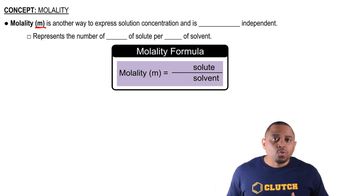Here are the essential concepts you must grasp in order to answer the question correctly.
Molarity (M)
Molarity is a measure of concentration defined as the number of moles of solute per liter of solution. It is commonly used in chemistry to express the concentration of a solution, allowing for easy comparison between different solutions. In this case, 1.75 M glucose indicates that there are 1.75 moles of glucose dissolved in one liter of water.
Recommended video:
Molality (m)
Molality is another measure of concentration, defined as the number of moles of solute per kilogram of solvent. Unlike molarity, which depends on the volume of the solution, molality is based on the mass of the solvent, making it useful for temperature-dependent scenarios. In this question, 1.75 m glucose means there are 1.75 moles of glucose per kilogram of water.
Recommended video:
Comparison of Concentrations
To determine which solution is more concentrated, one must consider both molarity and molality. Molarity is affected by the total volume of the solution, while molality is based solely on the mass of the solvent. In this case, the comparison requires understanding how the solute's mass and the solvent's volume interact, as the density of water and the volume occupied by glucose can influence the overall concentration.
Recommended video:
Oxyacid Strength Comparison
 Verified step by step guidance
Verified step by step guidance

